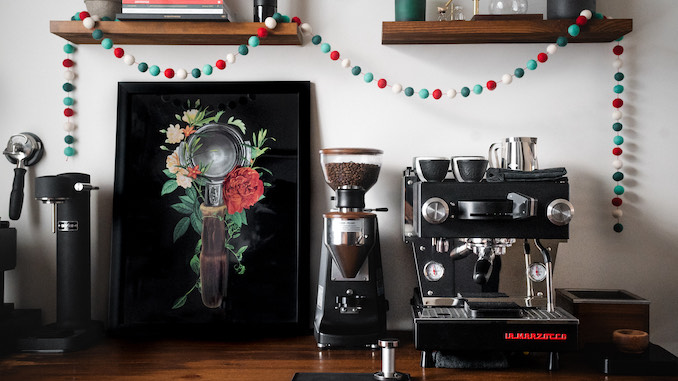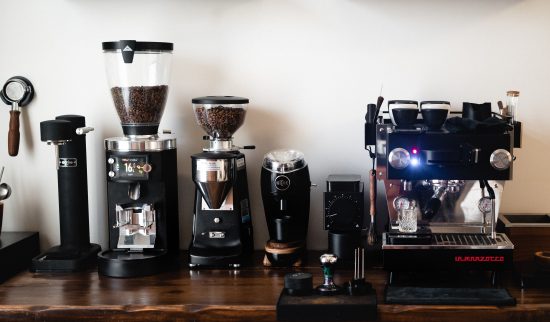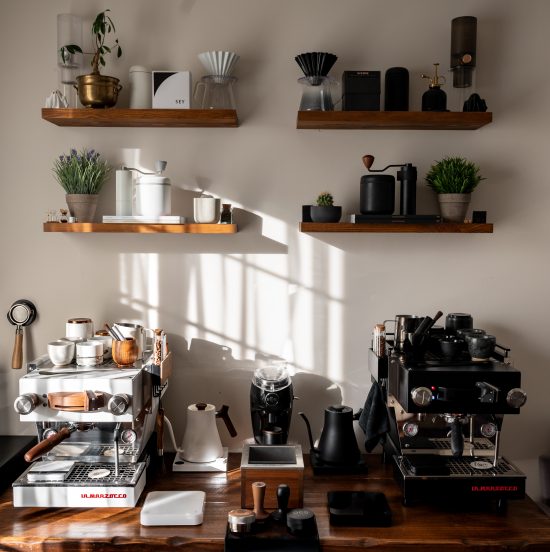
We explore the RAKO product developer’s coffee station and what tools he recommends to make great coffee at home.
BY TANYA NANETTI
SPECIAL TO BARISTA MAGAZINE ONLINE
Photos courtesy of Drago Tomianovic
Drago Tomianovic is not a new name in the specialty-coffee community. He is currently the director of product development for RAKO Coffee Roasters, a former barista, and nowadays an equipped home barista.

How Photography and Coffee Collided
Drago’s passion for coffee goes alongside his love for photography: In 2010 he started his own photography/videography business; in the last couple of years, he has combined these passions by sharing his photographs on Instagram while working simultaneously with big coffee brands, roasters, and cafés.
This love for photography—and obviously also for coffee—is probably what’s behind Drago’s current home setup, at least for what concerns the aesthetic of the home bar. Just a quick scroll on his Instagram page is enough to understand his preference toward black (preferably matte black) pieces of equipment. Along with all his proper coffee pieces on the shelves, he likes to add a couple of plants, some coffee-related books or magazines, and small miniature figurines of the brewing equipment he prefers to use most.
Drago’s Favorite Equipment
So what about that equipment? Drago’s home setup started with a Kalita and a Chemex, and slowly progressed to what it is today. Currently, he prefers to use, for his daily brews, the Orea V3 or the Stagg for pourovers, and the Linea Mini or Flair 58 for espresso.
He also loves to prepare a nice cold brew with his Timemore Cold Brew Dripper, and to entertain guests with a siphon whenever they go visit his home brew bar. The Niche Zero is his favorite grinder, together with a Lux D for espresso (but at the moment he’s also super excited to receive the KEY grinder by Weber Workshops in January). For filter coffee the first choice is the Ode with SSP burrs, or the Comandante if he feels like working out a bit. Last but not least, his favorite kettle is the Stagg EKG, which perfectly matches the Fellow aesthetics of his whole home bar.
A Good Bar Is More Than Good Equipment
Of course a perfect home bar setup doesn’t just consist of a long list of equipment. Some of the most important things to have in your home setup—according to Drago—are high-quality coffee, a good grinder, and good water.
Coffee, when possible, should always be purchased from some specialty roasters. Places that have their own transparency and share information about what’s behind it, giving a reason why their coffee is priced the way it is. This is really important because it helps make sure that the people at origin are getting paid their fair share, while at the same time having highly graded coffee.
Regarding the water, there’s obviously plenty of science behind it, but as a start, being able to test the alkalinity in the water you are using, as well as the Ph levels, will definitely help, Drago says.

Burrs Are Everything
Back to equipment: Getting a consistent grinder that has good-quality burrs is often more important than having a high-end machine. If you don’t have a high-quality grinder, your machine won’t perform as well as you think it should, while a great grinder will make even “just OK” machines perform incredibly well.
Of course there are many tools that can dramatically improve the quality of your brewing at home experience (as well as the quality of the end products), but Drago’s top five of “not essential but certainly very useful tools” includes:
- The Flair 58 puck screen for espresso
- A small spray bottle for RDT (Ross Droplet Technique, spraying beans with water to minimize static)
- A good WDT (Weiss Distribution Technique, a tool with fine needles to help stir the coffee in the portafilter) tool for espresso prep
- The Melo Drip for pourovers
- A good tamper
Talking about good coffee also means finding the perfect way to store it. After using various different methods, Drago has finally found the Fellow Atmos Canisters, and he acknowledges them as the most effective ones. He also vacuum seals some coffee and freezes it when he knows he won’t be able to drink it soon enough.
The Coffee Brewers Logbook
Finally, to make the coffee experience perfect even at home, a proper brewer logbook should always be present. Drago started logging his brews on a Google Sheet document, but he soon understood that he loves being able to manually log in his brews. That’s why nowadays, his “Coffee Brewers Logbook” is one of the highlights in his brew bar.
In his opinion, this is very important because it helps you understand all the different variables and changes you are making when brewing while on the path to reaching the “perfect” coffee.
ABOUT THE AUTHOR
Tanya Nanetti (she/her) is a specialty-coffee barista, a traveler, and a dreamer. When she’s not behind the coffee machine (or visiting some hidden corner of the world), she’s busy writing for Coffee Insurrection, a website about specialty coffee that she’s creating along with her boyfriend.

